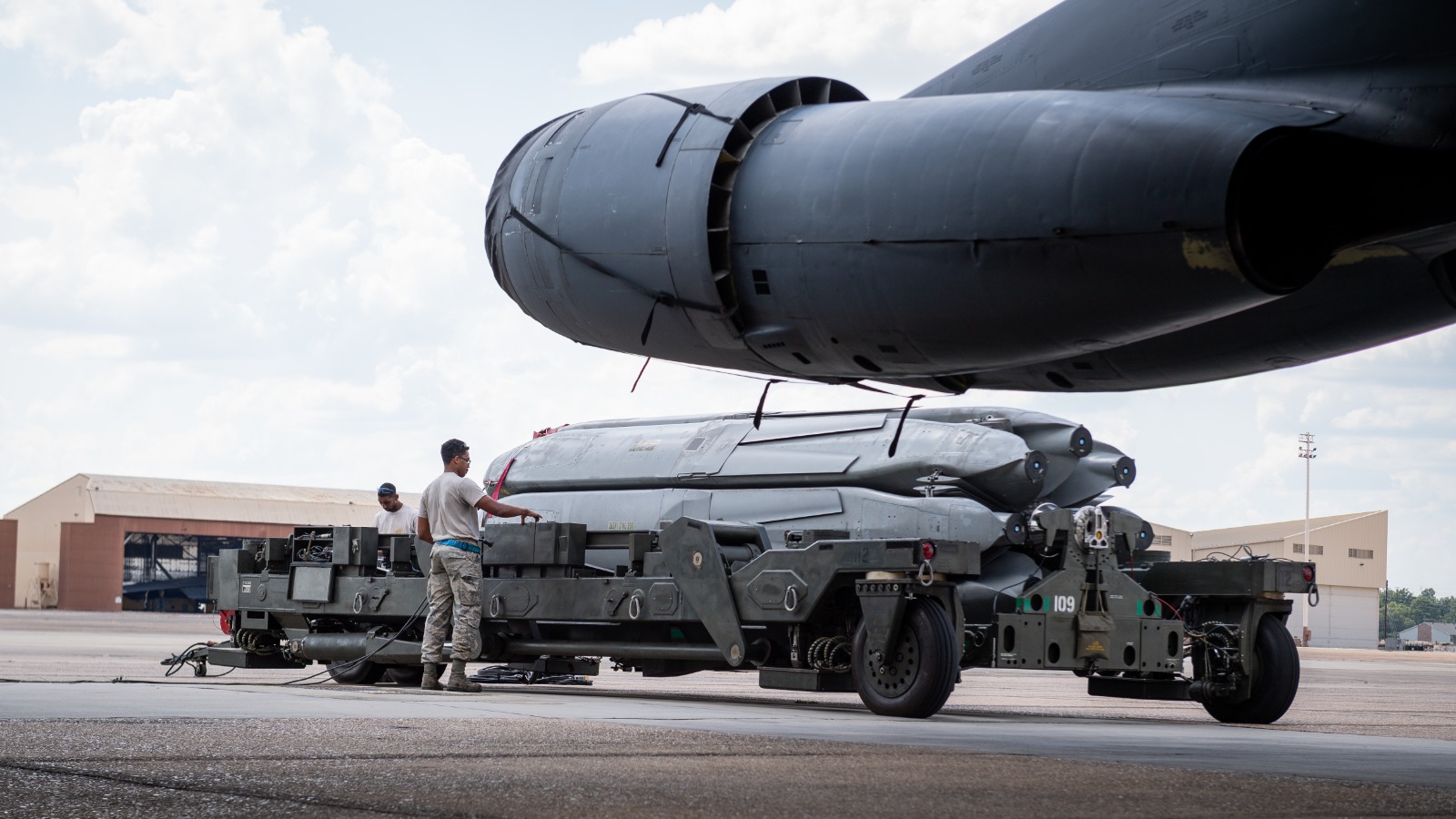The United States Air Force (USAF) is seeking new launching systems and electronics for the under-development AGM-181 Long-Range Stand-Off (LRSO) cruise missile to be fired from the B-52H Stratofortress bomber. It is also meant to be fired from the upcoming B-21 Raider as a tactical nuclear weapon (TNW).
The USAF said the 2022 testing brought out the missile’s specifications, causing issues with the B-52’s internal Conventional Rotary Launcher (CRL). A higher number of missiles causes them to clash with the fuel tank.
Considered provocative as it might induce a nuclear exchange with Russia and China due to miscalculations, it is feared that the weapon’s use could trigger retaliatory launches from the US’s adversaries.
However, the philosophy driving its induction is centered around giving a theater commander more flexibility to achieve strategic battlefield objectives.
Having a range of 1,500 miles (2,500 km), it is meant to replace the 1980s vintage AGM-86B Air-Launched Cruise Missile (ALCM). The long-range allows it to be fired from a greater distance, keeping the launching aircraft safe from most advanced enemy air defense missiles.
USAF budget documents and Pentagon reports reveal the service plans to procure around 1,000 such missiles, with 67 for testing. The service would decide on the production numbers and stages by 2027.

Cleared for Procurement
An April 2023 report said the AGM-181 LRSO “passed its critical design review” and is slated to enter low-rate initial production (LRIP) in 2027. By then, the “research, development, test, and evaluation” phase will have transitioned to a “procurement” stage.
At the time, it was said that the design was ready to face several “reviews” by “all stakeholders at any given time.”
President Joe Biden’s administration had confirmed the need for the AGM-181 LRSO in the 2022 Nuclear Posture Review (NPR). Raytheon (now RTX) won the LRSO contract in July 2021, beating Lockheed Martin.
Little is known about the LRSO’s kinematic capabilities, like the range and speed, but the USAF plans to build 1,087 of the missiles, of which some 67 would be used in the development phase.
Initially expected to cost about US$10 million each, the LRSO will cost US$13 million under 2023 estimates. The USAF’s 2024 budget requested US$978 million for the LRSO. The Air Force has also said the missile will not be hypersonic.
Missile Cleared Secret Tests in 2022
In October 2023, Air and Space Forces (ASF) reported that the LRSO had completed nine successful test flights, including “power on,” “free flight tests of all major systems,” and the “first full-system integrated test demonstrating design, manufacturing, and navigation maturing” the previous year in October 2022 itself.
These tests began in February 2022 and included powering up the missile’s engine from two B-52s earmarked for LRSO testing. According to a Pentagon report quoted by ASF, the nine successful tests in 2022 revealed:
- The LRSO’s ability to safely separate from the B-52
- Deployment of the missie’s flight surfaces, engine operations, and flight control actuation
- Capture controlled flight after employment from the B-52
By October 2022, the LRSO “demonstrated safe missile separation from the B-52, missile flight control deployment, engine start, and extended range operation, warhead-arming flight discrimination events, collection of the flight environment, and fire down sequence data for the warhead, and advanced navigation along a mission planned route using an operationally relevant Mission Data File.”
This year, 2024, is expected to witness the Director of Operational Test and Evaluation formulating a test plan for the LRSO that includes completing B-52 flight envelope testing and “Control Test Vehicle flight testing.” The program will also develop “carriage and launcher equipment, trainers, test equipment, and support equipment.”
Additionally, work is underway with the Department of Energy on designing, developing, and testing the LRSO’s nuclear warhead, integrating it with the missile, and planning for atomic certification activities.
Issues With Internal Rotary Launcher
A single hurdle mentioned in the Pentagon report – which the USAF said would be resolved by May 2023 – involved a “fit problem” in the B-52’s weapons bay. “Current calculations indicate that when four or more stores are loaded on the rotary launcher, the stores clash with the fuel tank,” the Air Force said.
The latest USAF request for information (RFI) seeking vendors who can design and manufacture new Carriage Equipment (CE) and electronic interfaces for operating the LRSO from the B-52 might address the weapons bay issue.
“The Carriage Equipment to be produced include the B-52 Suspension Underwing Unit (SUU)-72 conversion to SUU-103; Common Strategic Rotary Launcher (CSRL)/Conventional Rotary Launcher (CRL) conversion to the Nuclear Rotary Launcher (NRL); and manufacture of a Nuclear Stores Interface Unit inserted into SUU-103 and NRL. The Government’s intent is for industry to produce all three items simultaneously for field integration on the B-52,” the USAF wrote in the solicitation notice. Collectively, these systems are called the Bomber Weapon Interface Equipment (BWIE).
Guarantees Nuclear Clash?
Meant to offer a range of options to a theater commander during the war, the low-yield nuclear-capable cruise missile is expected to be used when stealth aircraft or bombers cannot fly within the direct striking range of enemy targets owing to advanced air defenses.
However, critics maintain that the use of the missile would be considered a first strike by Russia or China, who would retaliate with their nuclear weapons, triggering an escalatory cycle. Opponents reiterate that even low-yield tactical atomic bombs cannot conceivably guarantee a measured nuclear exchange if they are used as a primary warfighting tool and not in self-defense as a retaliatory weapon.
This is because immediately after its use, it would be difficult for any adversary to measure the impact and differentiate whether it was a more significant, high-yield, or smaller nuclear device until the dust settles. An adversary will have already set his nuclear launch procedures in motion in retaliation.
Moreover, there is no clarity on whether the battlefield/theater commander, most likely the chief of the Indo-Pacific Command (INDOPACOM) or the US’s European Command, would have complete autonomy in deciding the launch and not the ultimate sanction required by the President.
Will the launch authorization go up the chain, through the supposed National Command Authority (NCA) – from the battlefield commander to the Chairman of Joint Chiefs of Staff, the Secretary of Defense, and the POTUS? As per US law, only the President can authorize a nuclear launch with codes present personally with him and validated by the launching crew.
How such a reasonably long process can be completed quickly in a rapidly evolving and fluid battlefield situation when a commander decides to use a TNW is unclear. Both Russia and the US have nuclear safety procedures. For instance, the tactical nuclear-capable Iskander missiles Russia has stored in Belarus are operated only by a Russian crew and overseen by the RuMoD’s 11th Main Directorate, concerned with nuclear weapons.
The Kremlin is the last and ultimate authority in the chain that governs the complete process, from fusing the warheads with the delivery system (which are stored separately) to the final go-ahead to launch.
From a tactical perspective, the formal induction of a missile like the AGM-181 LRSO will lead Russia and China to assume that all weapons carried by the B-52 or the B-21 would be nuclear-tipped. This is because it is difficult to identify an enemy aircraft’s payload or the nature of its warhead – conventional or nuclear – during flight until it has landed.
This also raises the question of selecting a target for the missile, which, even if it is a military installation, might cause some civilian casualties, especially if it is in a city. Thus, US commanders would most likely select a battlefield formation on the frontlines that would only destroy enemy troops.
In the Pacific, this problem gets complicated as hitting Chinese military command centers in the mainland will invite a nuclear retaliation from Beijing. Targeting the People’s Liberation Army Navy (PLAN) shipping or militarized islands in the South China Sea (SCS) might also harm the US allies’ forces. The radiation spreading to the Philippines, Taiwan, or Vietnam would have its complications.
US Calculations
This may motivate a change in the US’s nuclear postures, poised to ‘launch on pre-emption.’ It is impossible that US leaders would not be aware of these risks, suggesting that Washington’s objectives behind the missile’s development are political and strategic, not military.
Knowing that neither Moscow nor Beijing wants a direct war, let alone a direct nuclear exchange, the US is possibly hoping to force them to enter into an arms control pact that limits their own nuclear weapons arsenal. The existence of the AGM-181 LRSO might achieve this end.
- The author can be reached at satamp@gmail.com
- Follow EurAsian Times on Google News




